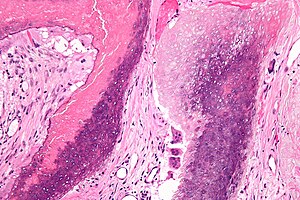Difference between revisions of "Pilomatricoma"
Jump to navigation
Jump to search
(+cat.) |
(split out) |
||
| Line 1: | Line 1: | ||
{{ Infobox diagnosis | |||
| Name = {{PAGENAME}} | |||
| Image = Pilomatrixoma_-_high_mag.jpg | |||
| Width = | |||
| Caption = Pilomatricoma. [[H&E stain]]. | |||
| Micro = "ghost" cells, foreign body-type giant cells | |||
| Subtypes = | |||
| LMDDx = | |||
| Stains = | |||
| IHC = | |||
| EM = | |||
| Molecular = | |||
| IF = | |||
| Gross = | |||
| Grossing = | |||
| Site = [[skin]] | |||
| Assdx = | |||
| Syndromes = | |||
| Signs = hard nodule | |||
| Symptoms = +/-painful | |||
| Prevalence = | |||
| Bloodwork = | |||
| Rads = | |||
| Endoscopy = | |||
| Prognosis = benign | |||
| Other = | |||
| ClinDDx = | |||
}} | |||
'''Pilomatricoma''' is a benign [[skin]] lesion that is common in childhood. It may be spelled '''pilomatrixoma'''. | |||
It is also known as '''calcifying epithelioma of Malherbe'''.<ref>{{Ref Derm|387}}</ref> | |||
===General=== | |||
*Benign skin tumour. | |||
*Most common solid skin tumour of children.<ref name=emed1058965>URL: [http://emedicine.medscape.com/article/1058965-overview http://emedicine.medscape.com/article/1058965-overview]. Accessed on: 10 September 2011.</ref> | |||
*CTNNB1 gene mutation important in pathogenesis.<ref name=Ref_PCPBoD8_597>{{Ref PCPBoD8|597}}</ref> | |||
Clinical: | |||
*Hard nodule - calcification. | |||
*+/-Painful. | |||
Treatment: | |||
*Surgical excision.<ref name=emed1058965>[http://emedicine.medscape.com/article/1058965-overview http://emedicine.medscape.com/article/1058965-overview]</ref> | |||
===Microscopic=== | |||
Features:<ref name=emed1058965dx>URL: [http://emedicine.medscape.com/article/1058965-diagnosis http://emedicine.medscape.com/article/1058965-diagnosis]. Accessed on: 10 September 2011.</ref> | |||
*Nodular circumscribed lower dermis/subcutaneous adipose lesion; thus, usu. surrounded by connective tissue. | |||
**Sharpy demarcated island of cells. | |||
**Calcification in 75%. | |||
*Cells:<ref>[http://www.bccancer.bc.ca/HPI/CE/cytotechnology/cytosleuthquiz/nongyne/ngcase02d.htm http://www.bccancer.bc.ca/HPI/CE/cytotechnology/cytosleuthquiz/nongyne/ngcase02d.htm]</ref> | |||
**Basaloid epithelial cells - have prominent nucleoli. | |||
**Anucleate squamous cells ("ghost cells"). | |||
**Giant cell foreign body type [[granulomas]] (form in reaction to keratin). | |||
Notes: | |||
*Keratin a prominent feature on cytology - lots of orange stuff. | |||
*May ossify. | |||
Images: | |||
*[http://www.bccancer.bc.ca/HPI/CE/cytotechnology/cytosleuthquiz/nongyne/ngcase02.htm Pilomatrixoma - cytology (bccancer.bc.ca)]. | |||
*[http://www.dermrounds.com/photo/1980062:Photo:431 Pilomatrixoma - histology (dermrounds.com)]. | |||
*[http://en.wikipedia.org/wiki/File:Pilomatrixoma_-_high_mag.jpg Pilomatrixoma - high mag. (WC)]. | |||
*[http://en.wikipedia.org/wiki/File:Pilomatrixoma_-_intermed_mag.jpg Pilomatrixoma - intermed. mag. (WC)]. | |||
DDx: | |||
*[[Epidermal inclusion cyst]]. | |||
*Pilomatrix carcinoma - invasive border, cytologic atypia, necrosis.<ref>{{Ref Derm|389}}</ref> | |||
*[[Squamous cell carcinoma]]. | |||
*[[Basal cell carcinoma]]. | |||
===Sign out=== | |||
<pre> | |||
SKIN LESION, RIGHT ARM, EXCISION: | |||
- PILOMATRICOMA. | |||
</pre> | |||
==See also== | |||
*[[Dermatopathology]]. | |||
*[[Non-malignant skin disease]]. | |||
==References== | |||
{{Reflist|2}} | |||
[[Category:Diagnosis]] | [[Category:Diagnosis]] | ||
Revision as of 15:47, 3 July 2013
| Pilomatricoma | |
|---|---|
| Diagnosis in short | |
 Pilomatricoma. H&E stain. | |
|
| |
| LM | "ghost" cells, foreign body-type giant cells |
| Site | skin |
|
| |
| Signs | hard nodule |
| Symptoms | +/-painful |
| Prognosis | benign |
Pilomatricoma is a benign skin lesion that is common in childhood. It may be spelled pilomatrixoma.
It is also known as calcifying epithelioma of Malherbe.[1]
General
- Benign skin tumour.
- Most common solid skin tumour of children.[2]
- CTNNB1 gene mutation important in pathogenesis.[3]
Clinical:
- Hard nodule - calcification.
- +/-Painful.
Treatment:
- Surgical excision.[2]
Microscopic
Features:[4]
- Nodular circumscribed lower dermis/subcutaneous adipose lesion; thus, usu. surrounded by connective tissue.
- Sharpy demarcated island of cells.
- Calcification in 75%.
- Cells:[5]
- Basaloid epithelial cells - have prominent nucleoli.
- Anucleate squamous cells ("ghost cells").
- Giant cell foreign body type granulomas (form in reaction to keratin).
Notes:
- Keratin a prominent feature on cytology - lots of orange stuff.
- May ossify.
Images:
- Pilomatrixoma - cytology (bccancer.bc.ca).
- Pilomatrixoma - histology (dermrounds.com).
- Pilomatrixoma - high mag. (WC).
- Pilomatrixoma - intermed. mag. (WC).
DDx:
- Epidermal inclusion cyst.
- Pilomatrix carcinoma - invasive border, cytologic atypia, necrosis.[6]
- Squamous cell carcinoma.
- Basal cell carcinoma.
Sign out
SKIN LESION, RIGHT ARM, EXCISION: - PILOMATRICOMA.
See also
References
- ↑ Busam, Klaus J. (2009). Dermatopathology: A Volume in the Foundations in Diagnostic Pathology Series (1st ed.). Saunders. pp. 387. ISBN 978-0443066542.
- ↑ 2.0 2.1 URL: http://emedicine.medscape.com/article/1058965-overview. Accessed on: 10 September 2011. Cite error: Invalid
<ref>tag; name "emed1058965" defined multiple times with different content - ↑ Mitchell, Richard; Kumar, Vinay; Fausto, Nelson; Abbas, Abul K.; Aster, Jon (2011). Pocket Companion to Robbins & Cotran Pathologic Basis of Disease (8th ed.). Elsevier Saunders. pp. 597. ISBN 978-1416054542.
- ↑ URL: http://emedicine.medscape.com/article/1058965-diagnosis. Accessed on: 10 September 2011.
- ↑ http://www.bccancer.bc.ca/HPI/CE/cytotechnology/cytosleuthquiz/nongyne/ngcase02d.htm
- ↑ Busam, Klaus J. (2009). Dermatopathology: A Volume in the Foundations in Diagnostic Pathology Series (1st ed.). Saunders. pp. 389. ISBN 978-0443066542.